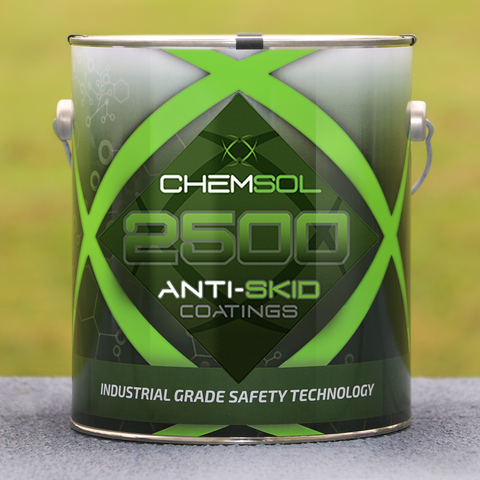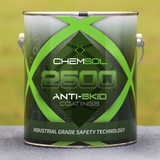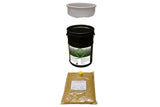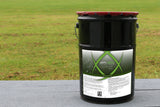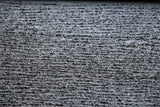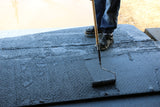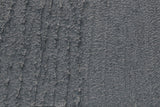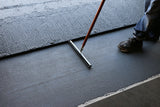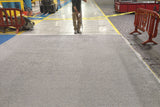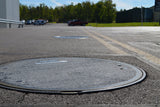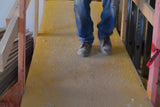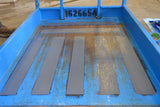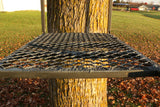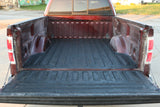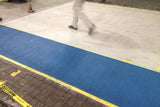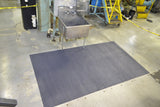Application Video
Complete Product Overview
| Chemsol | 75 | 7175 | 2500 | Navy G |
| Durability | 5 | 6 | 9 | 10 |
| Toughness | 5 | 6 | 9 | 10 |
| Hardness | 10 | 10 | 10 | 10 |
| Abrasion Resistance | 8 | 8 | 9 | 10 |
| Impact Resistance | 6 | 8 | 10 | 10 |
| Basis | Water | Water | Solvent-Free | Solvent |
| Recreational Use | Yes | Yes | Yes | Yes |
| Barefoot Use | No | Yes | No | No |
| Forklift Traffic | No | Maybe | Yes | Yes |
| Wear Resistance | 6 | 7 | 9 | 10 |
| VOC Level | 41g/L | 60g/L | 0g/L | 197g/L |
| Contain HAPs | Yes | No | No | No |
| Components | One | Two | Two | Two |
| Solid Content | 64% | 62% | 100% | 78% |
| Coverage/gallon | 70ft²/gal | 75ft²/gal | 35ft²/gal | 25ft²/gal |
| Thickness | 14 mils | 13 mils | 45 mils | 50 mils |
| Dry Time | 24 hrs | 72 hrs | 24 hrs | 24 hrs |
| Dry COF | 1.3 | 0.9 | 1.1 | 1.2 |
| Wet COF | 0.9 | 0.9 | 1.0 | 1.2 |
| Pot Life | N/A | 30-45 mins | 30-45 mins | 1-2 hrs |
| Temperature Resistance | 250°F | 250°F | 250°F | 250°F |
| Adhesion - Metal | 10 | 10 | 10 | 10 |
| Adhesion - Wood | 10 | 10 | 10 | 10 |
| Adhesion - Concrete | 10 | 10 | 10 | 10 |
| Low or Flat profile | Yes | Yes | Yes | Yes |
| High Profile | Yes | No | Yes | Yes |
| Ease of Application | 10 | 9 | 9 | 9 |
| Military Grade | No | No | No | Yes |
Chemsol 2500
Chemsol 2500: 100% solids, zero VOC, 2-part, epoxy, anti-slip coating designed for nearly all light and heavy duty use conditions.
Chemsol 2500 is most frequently used for:
- Areas where slip-resistance is required
- Light foot traffic up to heavy industrial rolling traffic
- High or low profile finish
- Aggressive to mildly-aggressive non-slip texture
Product Details
Description:
Chemsol 2500 is a two-component, zero VOC, HAP-free, 100% solids, fast curing epoxy anti-slip coating. It has been engineered to provide anti-slip protection and maximum durability in areas containing up to heavy rolling and pedestrian traffic. It is suitable for flooring, ramps, steps, and other areas where a durable slip-resistant surface is desired.
Chemsol 2500 is suitable for industrial, commercial, marine, and consumer environments. It is easy to apply and has very little odor which makes it ideal for use in odor-sensitive areas both indoor and outdoor. It is designed to adhere to a variety of surfaces including concrete, metal, wood, and other surfaces. Priming is recommended for best performance.
Chemsol 2500 is fire retardant when dry and has excellent chemical resistance to oil, gasoline, acids, caustics, hydraulic fluids, and most solvents. In splash and spill scenarios, it is resistant to a wide variety of acids and corrosive chemicals. It has a high coefficient of friction in both dry and wet operating conditions and is highly resilient to impact damage.
Chemsol 2500 meets USDA criteria for anti-slip compounds used in the areas of food processing, handling, and storage. It has been formulated to meet the strict requirements of South Coast Air Quality Management District Rule 1113.
Uses:
Designed for a one coat high-build application to substrates requiring supreme durability and resistance to chemicals, impact, abrasion and wear. Suitable for both indoor and outdoor industrial, commercial, marine, and residential applications. Offers a non-slip surface, and is also used in areas requiring enhanced damage tolerance and wear resistance. The surface texture (profile) is controlled at time of application through the use of various epoxy application tools.
Advantages:
- 100% solids
- Zero VOC; low odor
- HAPS free
- High durability
- High resistance to abrasion
- High resistance to chemicals
- USDA acceptable
Product Application:
Chemsol 2500 is a high technology epoxy coating that is suitable for commercial and industrial use. Thus, installation by professional epoxy installers is recommended. As with most high performance coating systems, the performance, durability, and overall efficacy of this product depends highly on correct surface preparation as well as on correct product application procedures. If surface preparation and/or application procedures are not followed, the product warranty will be voided. It is critical for proper product performance that surface preparation and application procedures are followed.
Atmospheric and General Notes:
- 24 hours prior to installation, store material between 70°F to 75°F (21°C to 24°C) for best results
- Substrate temperature should be between 70°F to 90°F (21°C to 32°C) for best results
- For best results humidity should be between 50% and 70% R.H.
- Moisture content should not exceed 3% for concrete substrates and 15% for wood substrates
- Allow for proper joints in substrates and do not overcoat joints
- Do not thin the coating
- After surface preparation and prior to applying primer, use masking tape to tape off any areas that are not to be coated. Note: pay special attention to joints, bolt holes, areas of contact or abrasion, or hinges: tape off any area that does not require coating. Important: prior to material drying, remove tape.
Surface Preparation:
Concrete: Completely remove oil, grease, dirt, and all other surface contaminants using a commercial grade cleaner/degreaser. Flush the area with water to remove any residue and allow to dry completely. Remove any paint, coating, contaminant, laitance, or loose concrete by scarification or blasting, or other mechanical means per NACE No. 6 / SSPC-SP 13 (Surface Preparation of Concrete). Smooth or glazed concrete surfaces should be roughened to improve adhesion. New concrete should be cured for at least 30 days prior to application. All release agents, hardeners, or sealers must also be removed. The concrete surface must be clean, dry, and abraded.
Metal: Completely remove oil, grease, dirt, and all other surface contaminants using a commercial grade cleaner/degreaser. Prepare the metal surface in accordance with NACE No. 2 / SSPC-SP 10 (Near-White Blast Cleaning). We recommend the SSPC-SP 10 standard over any type of power tool or mechanical cleaning or abrading. Galvanized (HDG) steel should be prepared in accordance with ASTM D6386. Contact Chemsol Technical Representative prior to preparing for installation on aluminum, galvanized, or specialty metals.
Wood: Completely remove oil, grease, dirt, and all other surface contaminants using a commercial grade cleaner/degreaser. Flush the area with water to remove any residues and allow to dry. Sand the surface to remove loose material and to create a surface profile for application. Ensure that surface is clean and free from saw dust and other contaminants. Wood must be dry.
Fiberglass/PVC/FRP/Tile: Completely remove oil, grease, dirt, and all other surface contaminants using a commercial grade cleaner/degreaser. Flush the area with water to remove any residues and allow to dry. Sand/abrade the surface to remove loose material and to create a surface profile for application. Ensure that the surface is clean and free from contaminants.
Other: Contact Chemsol Technical Representative prior to preparation or installation.
Priming:
An appropriate substrate-dependent primer is always recommended for best performance. Use Chemsol’s Waterborne Epoxy Surface Primer on porous surfaces such as concrete and wood. Use Chemsol’s Metal Primer on metal, fiberglass, PVC, and FRP surfaces. Prime metal surfaces immediately following blast preparation to prevent flash rust. For all other substrates, consult with a Chemsol Technical Representative.
Ensure that the primer is pore-free, pinhole-free, and provides uniform and complete coverage over entire substrate. Refer to the respective primer Product Data Sheet, MSDS, and application instructions.
Mixing:
Do not mix more material than can be applied within the pot life. Premix Part A separately. Always use the following mixing procedures.
Use a mechanical paint mixer, preferably a metal mixing blade attached to a hand-held drill. Do not use a paint shaker to mix the product.
Open Part A and premix Part A with the mechanical mixer. Use a moderate motor speed and avoid introducing air into Part A. Move the mix blade throughout the entire container – up and down, side to side, touching all side walls and bottom of the container, and throughout the middle of the container. Ensure that all aggregate is dispersed uniformly throughout Part A (aggregate can settle at the bottom of the container). Mix until a uniform consistency, including aggregate dispersion, is achieved. This should normally take about 3 to 5 minutes.
Empty the entire contents of Part B into Part A. A paint spatula or other tool should be used to ensure that all of Part B is emptied out of the container and into Part A. Always mix the entire contents of Part B with the entire contents of Part A. Mix the combined parts A and B with the same diligence as when premixing. Correct product performance depends on achieving a thorough mix. If the product is not mixed thoroughly, then the product may not cure properly. Use a moderate drill speed and avoid introducing air into the product. Move the mix blade throughout the entire container – up and down, side to side, touching all side walls and bottom of the container, and throughout the middle of the container. Ensure that all aggregate is dispersed uniformly throughout the mixture. Mix until a uniform consistency, including aggregate dispersion, is achieved. This should normally take about 3 to 5 minutes.
Application:
Application Methods: The recommended application method is spreading via roller, trowel, brush, or other epoxy paint application tool. Spraying is possible but not recommended. The finished surface texture is highly dependent on the application tool used. Read below for the recommended application tools and resulting textures. Consult a Chemsol Technical Representative with any product or application-specific questions.
Spread Rate: Apply Chemsol 2500 at a wft of 45 mils. Note: the film thickness will be an average value due to the course and uneven surface profile of the coating. Evenly applying Chemsol 2500 at a rate of approximately 35 ft2/gal wft is a general rule of thumb to achieve the overall recommended thickness. This coverage is an estimate and will vary under different circumstances. Ensure an even spread rate and avoid pooling and thick buildup.
Maximum Aggressive Texture Finish: Use a smooth phenolic core roller cover for maximum surface texture. Using a smooth phenolic roller cover will result in an aggressive “peaks and valleys” rough surface and will yield the maximum texture (surface profile). Pour a strip of non-slip coating onto the substrate. Use a moderate to heavy amount of downward pressure and roll the coating in one direction. During application, ensure that the roller is rolling and not simply “pushing” the non-slip coating. Downward pressure should be applied heavy enough to feel the aggregate under the roller as the roller is rolling and spreading the coating. Do not over-work the coating; one or two passes should be sufficient. Note: a straight epoxy floor squeegee (rubber or neoprene) can initially be used to spread the non-slip coating to the desired area once it is poured onto the substrate. Once the coating is spread with the squeegee, roll per the above procedure with a smooth phenolic roller cover.
Aggressive Texture Finish: Using a short hair (1/4 inch) nap roller cover will result in a moderately aggressive texture finish. The result will be similar to using a smooth phenolic roller cover, but with less overall aggressiveness and less peaks and valleys. Use the same application and rolling techniques as described above for using a smooth phenolic roller cover.
Notched or Troweled Finish: Using a notched rake (1/4 inch or other) or trowel will result in a raked finish with straight, uniform peaks generated by the application tool. The notched rake or trowel can be used immediately after pouring the coating onto the substrate, or, the notched rake or trowel can be used to rake the surface after an epoxy floor squeegee has been used to spread the coating.
Flat Texture Finish: Using a straight epoxy floor squeegee (rubber or neoprene) or paint brush will result in a flat surface finish (profile) without the peaks and valleys associated with roller or trowel application. Ensure that the coating is spread to the recommended coverage. Use a light downward pressure on the squeegee to smooth down any peaks on the surface of the non-slip coating. Push or pull the squeegee in one direction. Be careful not to “push” or “pull” and redistribute the non-slip coating; rather, the squeegee is used to flatten the peaks. Note: the surface will always have texture due to the nature of the aggregate package. This application technique, however, yields an overall flat surface profile compared to the other application techniques mentioned above.
General Limitations:
- Substrate Moisture Content: Moisture content of concrete substrate should not exceed 3%. For wood substrates, moisture content should not exceed 15%.
- Product Temperature: Optimum performance is achieved by preconditioning Chemsol 2500 for at least 24 hours between 70°F to 75°F (21°C to 24°C). Max temperature resistance once cured is 250°F.
- Ambient Temperature: Minimum 50°F (10°C); Maximum 85°F (30°C). We recommend application at temperatures at or above 70°F.
- Substrate Temperature: Minimum 50°F (10°C); Maximum 85°F (30°C); substrate temperature must be at least 5°F (3°C) above dew point.
- Relative Humidity: Maximum 85% for application and curing. High humidity will prolong curing.
- Thinning: Thinning is not recommended and will void warranty.
- Chemsol 2500 is intended for application by experienced professional installers only.
Chemsol warrants that its products meet its internal specifications and are of merchantable quality. However, the purchaser is solely responsible for the suitability of the product for any particular application. The purchaser should thoroughly test or qualify the product for serviceability, environmental compliance, and health and safety factors prior to use. Further, our total liability is limited to the price of the product or replacement in kind.
Technical Specs
MSDS
![]() MSDS for Chemsol 2500 Anti Skid Safety Coating, Part A, Medium Grey, Gallon
MSDS for Chemsol 2500 Anti Skid Safety Coating, Part A, Medium Grey, Gallon
![]() MSDS for Chemsol 2500 Anti Skid Safety Coating, Part B, Quart
MSDS for Chemsol 2500 Anti Skid Safety Coating, Part B, Quart

